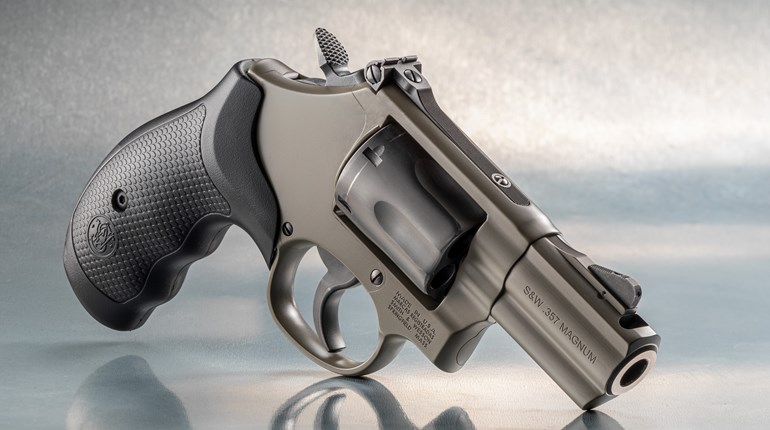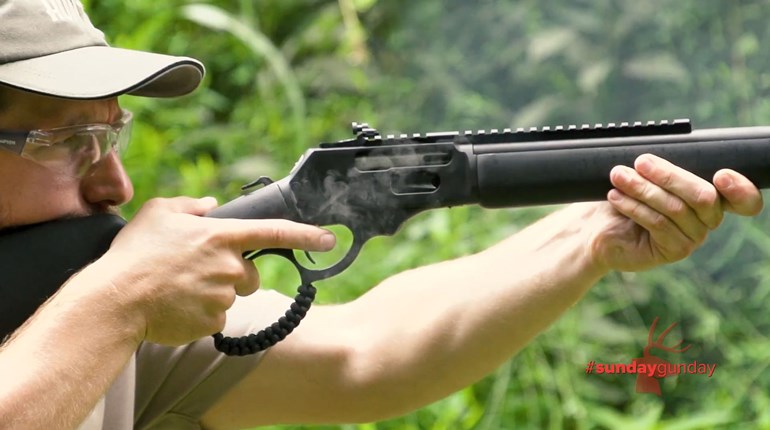
WARNING: All technical data in this publication, especially for handloading, reflect the limited experience of individuals using specific tools, products, equipment and components under specific conditions and circumstances not necessarily reported in the article and over which the National Rifle Association (NRA) has no control. The data has not otherwise been tested or verified by the NRA. The NRA, its agents, officers and employees accept no responsibility for the results obtained by persons using such data and disclaim all liability for any consequential injuries or damages.
Modern revolver shooters have repurposed an old cartridge to be at the top of their game. The .38 Short Colt was created in the late 1800s as a metallic cartridge conversion for the cap-and-ball Colt 1851 Navy Revolver from the Civil War. Today’s competitive revolver shooters have adopted it due to its short case, which makes it faster to eject and reload than the common .38 Spl.

The Short Colt shares all dimensions with the .38 Spl., except length. A .38 Spl. case is 1.155 inches long, and the .38 Short Colt is .761 inch long, and will fit in .38 Spl. and .357 Mag. revolvers.
Factory ballistics for the .38 Short Colt are a 125-grain bullet at 730 f.p.s. from a fiveinch barrel (Remington ballistics) for a power factor of 91. Most disciplines require a higher power factor, e.g., NRA Action Pistol and ICORE require a minimum power factor of 120. USPSA’s minimum minor power factor for Revolver division is 125. Steel Challenge has no minimum power factor, so even wimpy loads are welcome there. IDPA does not allow the .38 Short Colt. Well, technically, the rule says the ammunition must match the cartridge listed on the firearm. The exception is that .38 Spl. can be used in a .357 cal. revolver.

To meet the higher power factors required in many disciplines, you have to load the .38 Short Colt past its usual pressure limit. Starline says the .38 Short Colt is rated for only 12,000 CUP (Copper Units of Pressure). But they make .38 Short Colt brass the same as their .38 Spl., so it can be run up to 20,000 CUP or around 18,500 p.s.i. Loading to meet a 125+ power factor often means loading past these values.
A .38 Short Colt case is nearly the same length as a 9 mm case, being 0.761 and 0.754 inch, respectively. Loading to this length to reach the 125+ power factor often means running the pressure to around the same as you would to get the 9 mm to that same power factor, which is past 18,500 p.s.i. The 9 mm’s SAMMI maximum pressure limit is 35,000 p.s.i., and some .38 Short Colt loads will be in that neighborhood to make the higher power factor.

Starline does not recommend loading its .38 Short Colt brass to those pressures, but know that competitors do that. As Starline notes, “It’s kind of one of those ‘at your own risk’ type of deals.” Starline says to watch for signs of excess pressure that can take the form of “primer flattening/flowing into firing pin hole, and sticky extraction.”
The short length of the .38 Short Colt case means they completely clear the chamber of full-sized guns when ejected. A .38 Spl. case can still have a bit of the case inside the chamber even with the ejector rod fully pressed. My Smith & Wesson 686 four-inch has an ejector rod push length of 0.970 inch, and the tip of a .38 Spl. case is still in the chamber at full ejection. A .38 Short Colt has cleared it by a mile.

Since it’s all about speed—reloading, as well as ejecting—round nose bullets rule since they more easily align with the chamber. All the lead bullets I used are .358 inch, and there are round nose versions for most bullet weights from 95 grains to 160 grains. Round nose jacketed bullets in .38 cal. (.357 inch) are not so easy to find. But Armscor sells 125- and 158-grain full-metal jacketed versions as a component, and Berry’s makes a 158-grain round nose plated .357 bullet.
You can use round nose 9 mm bullets as well, and they are included in the data, but there are some things to consider. Their smaller diameter (.355 and .356 inch plated) often result in less neck tension because .38 caliber brass and reloading dies are generally designed around .357- and .358-inch bullets.

If the bullets are not held securely in place, you might experience bullet creep from recoil—bullets backing out of the case. When bullets do creep, their longer overall length reduces pressure, resulting in slower velocity which reduces your power factor. You’ll need to watch for this so you don’t end up failing to make power factor at the chronograph at a match.
I experienced some bullet creep in my test loads with .355- and .356-inch jacketed and plated bullets. A heavy crimp can help reduce this, but may cause problems by stripping the plating off plated bullets, or coating off coated bullets, which can result in leading. Increase neck tension with undersized bullets by using a .355 expander (9 mm) instead of the .357-inch (.38/.357) expander. An undersize sizing die coupled with a .355-inch expander will help, too.

Case volume is an important factor in determining chamber pressure. Measurements of case capacity showed that Starline’s .38 Short Colt brass have a little more capacity than the typical 9 mm brass. I trimmed virgin cases to the same length of 0.748 inch and measured (three times) how much Accurate #7 powder they would hold. Starline’s .38 Short Colt case held an average of 14.62 grains. Starline’s 9 mm case held 14.28 grains. For comparison, a Lapua 9 mm case held 13.97 grains, and a Winchester nickel-plated 9 mm case held 14.32 grains. When loaded with the same powder and bullet to the same overall length, the .38 Short Colt case should produce slightly less chamber pressure than a 9 mm case. This is handy to know when using 9 mm load data for Starline .38 Short Colt cases.
Overall length is an important consideration for these loads for reliable loading from a speedloader. If you’re using moonclips, you can load them to whatever overall length you want, and loading them on the short end might assist loading—that’s something you have to test for yourself. With speedloaders, the bullets need to be loaded long enough to ensure the bullets have partially entered the chamber for good alignment before they are released from the loader. Loads with long, heavy bullets can be seated to 1.180 to 1.200 inches to aid alignment. This also helps to keep chamber pressure low.
Lightweight bullets can’t always be loaded to long length, because there needs to be enough bullet shank in the case for a good grip on the bullet. With the shortest bullets I used, the 95-grain round nose cast bullets, loaded to 1.1 inch, they were long enough the get the tip of the bullet in the chamber from my Safariland Comp III speedloaders. The shortest I loaded the other bullets was 1.140-inch (115-grain Hornady FMJ round nose). They seemed to align okay at that length from my Comp III speedloaders.
As mentioned, overall length affects peak chamber pressure. For a given load, seating the bullet deeper increases pressure and velocity. This is demonstrated with a 147-grain Blue Bullets load using 3.7 grains of Bullseye. When seated long to 1.180 inches, it produced 878 f.p.s. When seated deeper at 1.140 inches, it was 27 f.p.s. faster, a gain of four power factors. You can change power factor by changing overall length, but keep in mind that seating the bullet deeper increases chamber pressure. Watch this closely to avoid pushing pressure too high.
I used published 9 mm load data as a guide to keep peak pressure within safe limits. Many of my loads were at a longer overall length than the 9 mm data used, and this helps to keep pressure low. Nevertheless, some loads were near the limit of 9 mm loads. The higher-pressure loads should only be used in guns chambered in .357 Mag., which has the same SAAMI maximum chamber pressure of 35,000 p.s.i. as the 9 mm.

Gunpowder selection leans toward fast burn rate powders, because fast powders generally use less weight to reach a given speed than slow powders. Since powder weight is included in the ejecta and part of the formula to calculate recoil force, less powder weight for a given velocity means less recoil.
The only downside to using fast powders is they reach maximum chamber pressure at slower velocities than slow powders. So, there is a balance of trying to reach your desired velocity while keeping pressure within safe limits. The powders I used can generally do that, but it’s another reason to consult a loading manual as you work up your loads to ensure safety. That said, the gas effect is not much. If you’re getting sticky cases, try a slower powder to reduce the pressure enough to stop the stickiness.

I’ve included how much recoil the loads produce (in a 2½-pound gun) as a general guide. It also shows you just how low the recoil can be with really light loads. In those cases, keep the slowest speeds above 600 f.p.s. to reduce the chance of bullet sticking in the barrel.
These .38 Short Colt handloads were fired in a Smith & Wesson Model 686 with a four-inch barrel. Longer barrels should produce higher velocity, but you’ll need to use a chronograph to make sure loads in your gun will meet the desired power factor. Work your loads up, watch for pressure signs—and be safe.



































